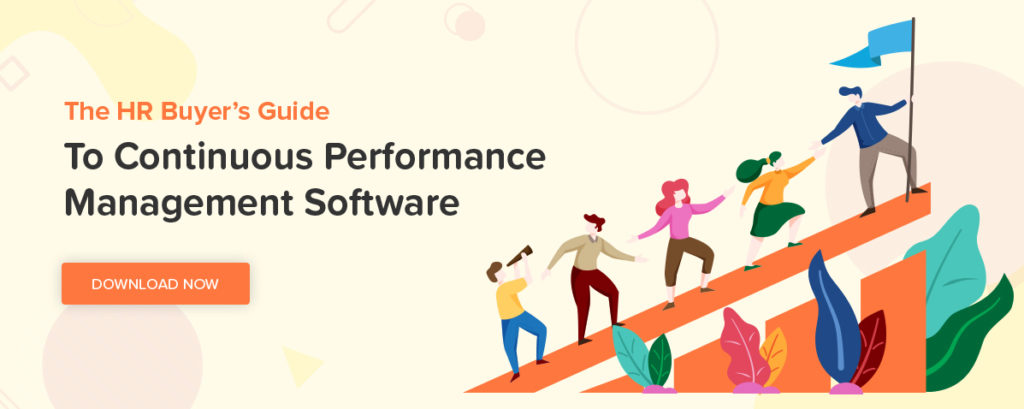New Guide: Choosing Employee Performance Software To Ease Common HR Pain Points
If our collective experience has taught us nothing else, it’s that modern Human Resources teams face increasingly complex challenges. On top of that, HR is disproportionately appreciated relative to the importance of their role, which is broader than many realize.
It’s not all doom and gloom for People Ops, though! Yes, corporate roles like these can be tough, but if you approach them the right way you can simplify both short- and long-term tasks while gaining kudos from your peers in the process.
Twenty-first Century technology can be a boon to productivity no matter what your department. So let’s use it! To get you started, we’ve compiled a comprehensive HR Buyer’s Guide to help you search for and select continuous performance management software that fits your company philosophy and specific needs.
Our step-by-step guide examines various best practices that together can lead to a big win for your team. It also includes a walk-through of this process in action featuring one of the most experienced People Ops leaders in the game today.
Let’s take a closer look at what you’ll find inside our HR Buyer’s Guide.
Step 1: Identify HR Pain Points
Doctors don’t prescribe treatments until they diagnose symptoms, and you shouldn’t either. In this case, your stethoscope takes the form of a fundamental needs assessment. This employee survey not only begins to uncover the roots of People Ops issues, it also shows employees that their opinions carry weight with leadership.
In our guide, we recommend inquiring into four key areas and include sample questions for each. Keep these areas in mind as you compile your own assessment:
• Employee growth and development
• Employee Compensation and promotion
Step 2: Conduct Due Diligence
Just as important as internal analysis is external research. You’re not the first team to evaluate their company’s HR state of the union. Existing data collected by other organizations can strengthen your argument for modernizing People Ops. This can go a long way in swaying both hesitant executive decision-makers on the front end and resistant managers on the back during implementation.
Our guide integrates findings from industry analysts such as HR tech advisor George LaRocque and the Bersin by Deloitte research team. We expand upon the various mechanisms their data support for continuous performance management, including:
• 1-on-1 meeting agenda tracker
• Goal setting / OKRs (Objectives and Key Results)
• Annual performance review alternative
Step 3: Analyze HR Solution Options
There are a host of solutions vying for your business once you decide to move forward. On the one hand, this is great because competition drives innovation and checks pricing. On the other, the sheer number of options can be overwhelming.
We discuss this in more depth in our guide, including the merits of establishing search criteria up front and then leveraging existing resources to do much of the legwork for you. For instance, G2 Crowd’s software comparison function can be a great asset during this process.
Step 4: Gain Executive Buy-In
You may have come up with the greatest HR strategy in modern times, but it will go nowhere quickly unless you have the initial approval and ongoing backing of your leadership team. To do this, you need to demonstrate why the new performance management software you’ve chosen is important and how the entire organization will be better off by using it.
Specifically, our Buyer’s Guide dives into six ways for People Ops teams to accomplish this effectively:
• Testing – go for a test run first rather than a wholesale change
• Benefits over features – how it works is less important than how it helps
• Risk analysis – nothing is perfect, be upfront about both the pros and the cons
• Culture – connect your plan directly to the company’s core values
• Social proof – success stories from other businesses can be powerful influencers
• Roadmap – show that you’ve thought everything through from concept to rollout
Case Study: Colleen McCreary and Credit Karma
Colleen McCreary has been revolutionizing People Ops since the days of the first iPod. A veteran of various HR departments at successful companies like Vevo, Climate Corporation, and Zynga, Colleen currently serves as the first-ever Chief People Officer at Credit Karma. When she took up this post, Credit Karma was experiencing internal growing pains as part of its expansion from startup to billion-dollar enterprise.
In short, Colleen became a force of positive disruption for the company. Our case study details how she approached modernizing People Ops processes, used internal findings and external research to build a compelling case for change, and secured C-level support ahead of successful implementation.
Colleen’s accomplishment at Credit Karma is a great example, but it’s not the only one. By finding the right way to navigate the performance management software waters, you can join Colleen and other forward-thinking People Ops leaders making a much-needed splash in their organizations. Let our HR Buyer’s Guide be a launching pad for your own journey and know that our team is here to help you along the way.

David Mizne is Marketing Communications Manager at 15Five, continuous performance management software that includes weekly check-ins, objectives (OKR) tracking, peer recognition, 1-on-1s, and 360 reviews. David’s articles have also appeared on The Next Web & The Economist. Follow him @davidmizne.
Image Credit: Flavius Les on Unsplash





